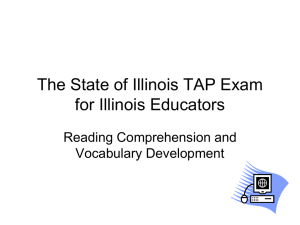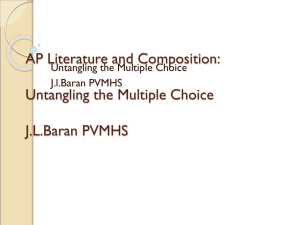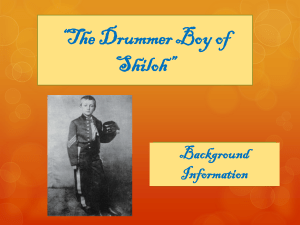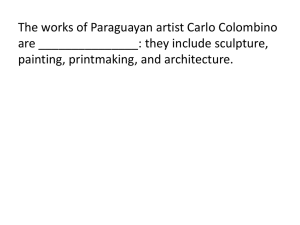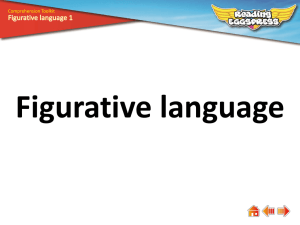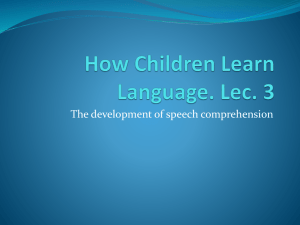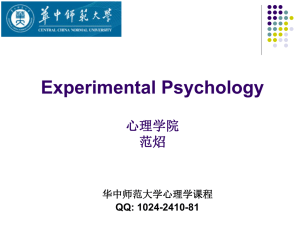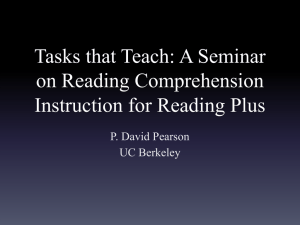Working Memory Capacity and Processes - CELTA
advertisement
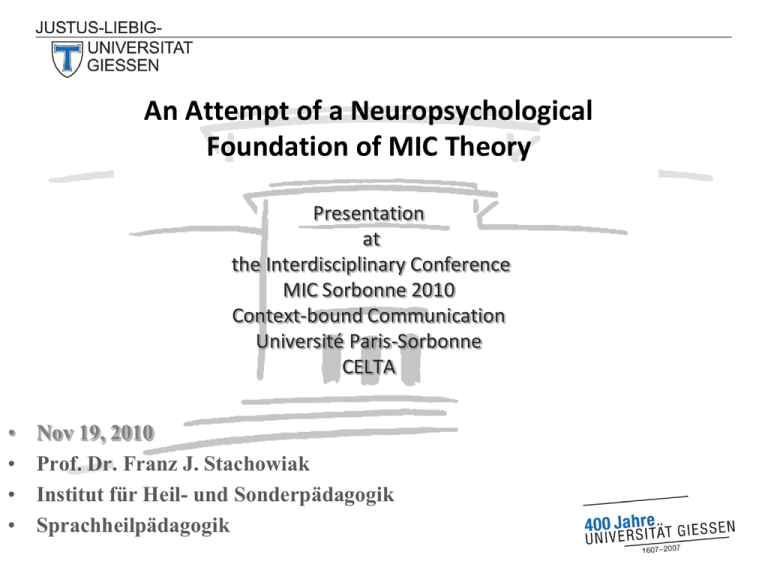
An Attempt of a Neuropsychological Foundation of MIC Theory Presentation at the Interdisciplinary Conference MIC Sorbonne 2010 Context-bound Communication Université Paris-Sorbonne CELTA • • • • Nov 19, 2010 Prof. Dr. Franz J. Stachowiak Institut für Heil- und Sonderpädagogik Sprachheilpädagogik OUTLINE OF THE PRESENTATION 1. 2. 3. 4. 5. 6. 7. 8. Introduction Some examples from German as a FWO language New and old information from a neurobiological perspective Human memory as a differentiated system and its relation to text comprehension Working memory capacity and processes form the basis of topiccomment structuring and meta-informative processing in language Attention; Topic and Comment and other centers of informational saliency in texts The MIC Component in models of language production and comprehension Neurolinguistic findings: text comprehension in aphasia 1. Introduction • In the following I will try to establish a connection between some aspects of the MIC Theory and neuropsychological findings about memory and attention. I will argue that verbal processing of information is strongly influenced by or even rests on the capacity and mode of operation of working memory and other types of memory and is intricately related to attentional processes. In fact I assume that the basic slot structure for marking the information as new or old in verbal utterances derives from operational principles, limits and strategies of working memory as a gate to long term memory. • Ericsson and Kintsch (1995) have presented a model of text comprehension, in which they assume an interaction of two kinds of processes: the short term activation of information while text segments are being processed and the storage and retrieval of information that forms episodic text structures in long term memory. However, their psychological approach lacks some linguistic fundamentals. 2. Some examples from German as a FWO language Mein Mann Kann morgens gut Kaffee Kochen Variations Interaction of pragmatic and grammatical factors 3. New and old information from a neurobiological perspective 4. Human memory as a differentiated system and its relation to text comprehension Classification of Memory Types Working Memory Working memory refers to our capacity to simultaneously process and store information. According to Baddeley´s (2003) model working memory consists of several subcomponents which play an active role in the process of holding new information while processing or changing it in the visual and the verbal system (for instance in text production and and comprehension). The central executive serves the attentional control of information that is actively dealt with in the visual or verbal subsystems and it controls the transfer of information from and to long term memory. In other words, this component is a good candidate for a mechanism that is engaged in pragmatic decisions on the meta-informative status of information as organized in utterances 5. Working memory capacity and processes form the basis of topic-comment structuring and meta-informative processing in language • George A. Miller (1956) : the magical number 7 plus or minus 2, number of information units that an average human can hold in working memory. • In a very careful literature review Nelson Cowan (2000) came to the conclusion that a single, central capacity limit between three and four unrelated chunks, which can be attended at one time, characterizes human short term meory. Chunks are understood as a collection of concepts that have strong associations to one another and much weaker associations to other chunks currently in use. • Memory span = maximum list of items that a person can repeat correctly immediately after presentation Working Memory Capacity • Waugh and Norman (1965) investigated the causes for forgetting. In their probe method they presented lists of random numbers such as 5 2 6 8 7 2. Only the last number, here the 2, appeared twice. This repeated number was called the “probe”. The subjects were asked to pay attention to the appearance of the “probe” and then report the number that had followed the probe after its first appearance in the list, i.e. the 6. Working Memory Capacity and Processes • • • Sternberg (1966) examined whether we search the elements that are held in working memory one item at a time (serially) or all at once (in parallel) and whether this search stops when the item is located (self-terminating search) or whether it continues till the entire content of the memory store has been checked (exhaustive search) even if a match was found beforehand. He concluded that the search is serial and exhaustive. Scanning a brief list of digits contrasts sharply with a higher cognitive task, in which the information is related to other information and is available to a person within a communicative or situational context or which he/she might have stored in long term memory. Considering the mass of information exchanged in verbal communication, it must be assumed that an exhaustive serial search of all items of a given linguistic surface structure would prevent the decoding of the message rather than support it. Considering these results together, it becomes understandable why centers of attention within a text are used as boot straps against the decay of information on the one hand and against inefficient unterminated scanning processes on the other. Working Memory Capacity and Processes The serial position effect The serial position effect: basis of topic and comment? • The serial position effect refers to the fact that in free list recall – i.e. when subjects are asked to recall the items of a list of digits, words or other symbols in free order – the accuracy of the recall depends on the position of the items in the list. In immediate recall the last items of a list are usually better remembered than the first ones (Recency Effect). The first items of the list are better recalled than the middle ones (Primacy Effect). An explanation of the recency effect is that in short-term memory the processing of new items overwrites old ones. At the time of recall the last ones have not been overwritten and are still held active in working memory. The primacy effect comes about, because initial items are more readily encoded into long-term memory, as they could be rehearsed before new items came to be processed. Thus in recall the first items are retrieved from long term memory. They can also be processed by tghemselves, whereas the following ones have to be incrementally dealt with together with the subsequent items. The recency effect is eliminated when an interfering task is given before recall, as the new task requires attention and processing capacity. Fast presentation of the items reduces the primacy effect. Very late recall increases it. Reading Span • As it was recognized that memory span for symbols such as digits, letters or single words is only weakly related to demanding cognitive tasks such as text processing, a more complex type of span was developed with the purpose of jointly tapping the storage and processing functions of Working Memory (Danemann and Carpenter, 1980). The reading span task consists in the presentation of groups of sentences which the test persons are asked to read aloud. After that they are required to recall, in the sequential order in which the sentences were presented, the last word of each sentence. • The original reading span task was used in a variety of versions (see Conway et al. 2005), which regularly showed impressive correlations with language comprehension and other language processing tasks. The necessity of Centers of Attention • Although these psychological studies do not investigate meta-informative strategies in sentence and text processing directly - a task that calls for more linguistically based research - it appears that some basic neuropsychological preconditions for dealing with new and old information in texts can be traced in these results. The limitation of working memory capacity is a factor in a cognitively demanding task such as text production and comprehension. It imposes the necessity to select centers of attention as bootstrapping devices to cope with the workload of simultaneously storing and manipulating bits of information and arranging the linear surface structure in such a way that communication partners are supported in decoding the gist of the intended message. In this sense the skillfull filling of the slots of a sentence´s topological field structure as for instance in sentence (3) is part of necessary and universal properties of language induced lastly by human biology and cognitive capabilities. 6. Attention; Topic and Comment and other centers of informational saliency in texts • “Everyone knows what attention is. It is the taking possession by the mind, in clear and vivid form, of one out of what seem several simultaneously possible objects or trains of thought. Focalization, concentration, of consciousness are of its essence. It implies withdrawal from some things in order to deal effectively with others, and is a condition which has a real opposite in the confused, dazed, scatter-brained state which in French is called distraction, and Zerstreutheit in German” (James, 1890: 75). • Broadbent (1958). the classical filter model • Treisman and Geffen (1967): the “attenuator” model of attention • Norman (1968): the Pertinence Model of Selection and Attention The pertinence model of selection and attention Attention Capture • Relevant chunks of information in human language need to be marked in such a way as to catch the attention of the communication partner. Word order change and intonation may be primary instruments, but equally and additionally effective are “adverbial” lexical focus markers such as “eben” (“just”), “gerade” (“exactly”), “insbesondere” (“especially”) which can even be used cumulatively in order to draw the attention to that part of the information that is considered as particularly relevant by its producer. My colleague Henning Lobin, who has written a book on “Computerlinguistics and Text-Technology” applied this instrument in his introductory speech to the conference “Digital Science” (20.09.2010 in Cologne) when he said: CA Marking • (6) Und auch hier wird gerade im BMBF ja eine Art Integration all dieser Förderungen diskutiert, eh.. eine Zusammenführung dieser eh ..Fördervorhaben, die eh.., wenn man sie alle zusammenrechnet, ein unglaublich hohes Fördervolumen auch im Moment aufweisen, um eben gerade insbesondere im Bereich der Gesellchaftswissenschaften, Geistesund Kulturwissenschaften so etwas wie ein E-Science Initiative ins Leben zu rufen” • “... and also here is in the BMBF (Federal Ministry of Education and Research) surely a kind of integration (of) all those eh – fundings being discussed, eh... a joining (of) those support projects, which eh... , if one them all together counts, an unbelievably high funding volume also at the moment exhibit, in order to just exactly especially in the area of the social sciences, arts and cultural sciences (so) something like an E-Science initiative into life to call”. • CA Marking The speaker is guided by the listener´s need for attentention capture aids The MIC-Component in models of language production and comprehension Where to place the MIC Component? Evidence from Speech Errors A MIC-Component in language comprehension 8. Neurolinguistic findings: text comprehension in aphasia Grammatical Problems are compensated by „contextualization“ factors Less „redundancy“ – more comprehension problems The MIC-Component in language comprehension needs input Word order variation and text comprehenion in aphasia Vielen Dank für Ihre Aufmerksamkeit Many thanks for your attention! Remagen am Rhein

